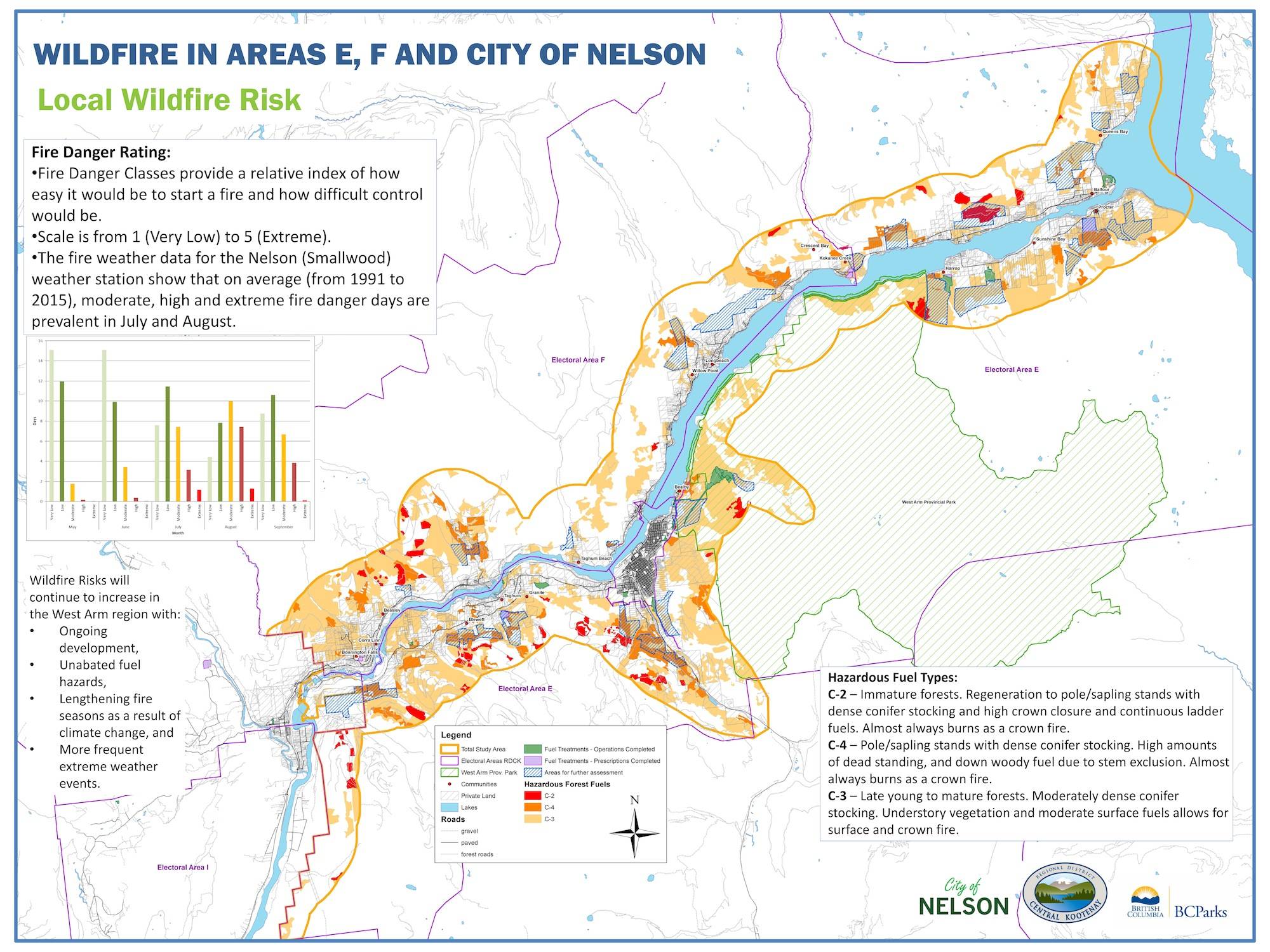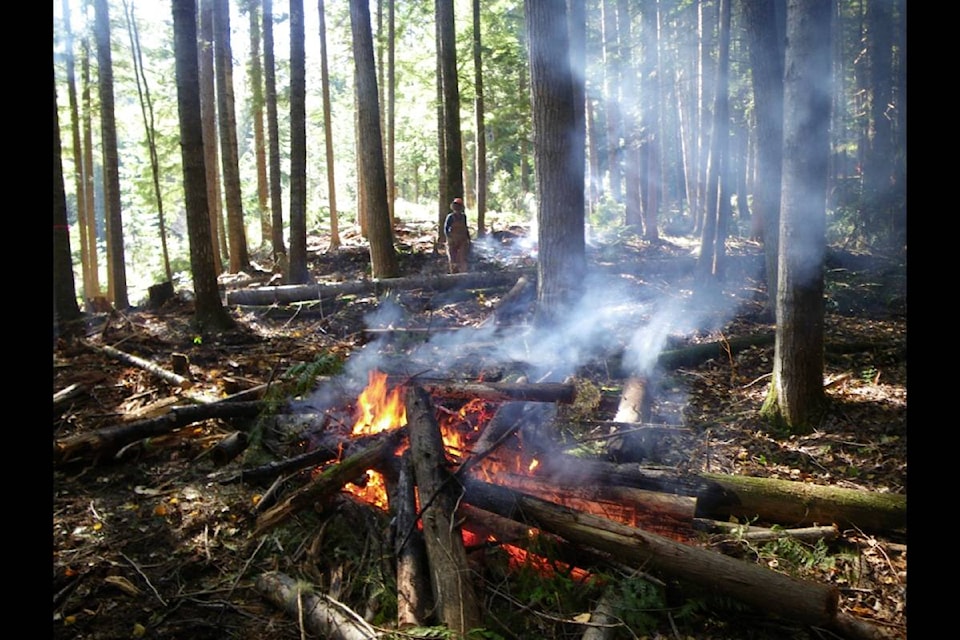A plan exists to protect Nelson from wildfires, but it will take time and money to carry it out.
The crown areas most at risk of wildfire in the vicinity of Nelson are in the drainages of Giveout Creek, Selous Creek, and Five Mile Creek.
That’s according to Nelson’s Community Wildfire Protection Plan (CWPP), adopted by city council in 2016. The plan (attached below) also lists many other fire-prone areas.
What those places need, says the plan, is fuel mitigation treatment.
That means modifying forest vegetation by retaining large dominant trees, thinning and removing small trees, and then pruning the lower parts of the retained trees, according to forester John Cathro.
“It also means keeping fire resistant trees like Douglas fir, western larch, ponderosa pine, and deciduous trees, and removing species that are not fire resistant like cedar, hemlock, and lodgepole pine,” he says.
Cathro is a fuel mitigation consultant and one of the co-authors of Nelson’s wildfire plan, which is attached to the online version of this story at nelsonstar.com.
The next step in fuel mitigation is to remove all wood debris from the ground. The final result would be a forest of large fire-resistant trees with no underbrush, small trees, or debris.
“What we are trying to do is reduce the fire intensity and the fire behaviour,” Cathro says. “We are not trying to stop fire, we are trying to create the conditions so that a forest fire can be actioned from the ground rather than solely from the air.”
To carry out that work is expensive, and it involves input from a dizzying range of overlapping jurisdictions and interests: the city, electoral areas E and F of the RDCK, the provincial parks department, recreation stakeholders, First Nations, water licensees, utility companies, railway lines and timber companies.
(That list does not include private landowners. The fuel treatment plans do not include private land, because the government can not tell private owners what to do on their property. But it can educate and encourage them and that’s part of the wildfire plan, too.)
Where the money will come from
Nora Hannon, the RDCK’s wildfire mitigation co-ordinator, has the daunting job of organizing all those agencies and getting funding to do the work.
She explains that areas E and F, and West Arm Park, each have their own fire protection plans and that those plans are generally in agreement with Nelson’s on what the most dangerous areas are.
“I believe (this kind of collaboration) is a first, provincially, and it was done to address fuel modification on a landscape level,” Hannon says.
Funding for local governments to do fuel mitigation work is available from the Union of B.C. Municipalities (UBCM) and the Forest Enhancement Society.
The UBCM will fund up to $600,000 for regional districts and $400,000 for municipalities, but that money is being significantly topped up by the Forest Enhancement Society, an organization set up by the provincial government for the prevention of wildfires. Local communities are required to pay a small from 10 to 25 per cent of the cost as well.
The work is expensive ($10,000 per hectare plus additional planning costs) and the application process is complex or, as Hannon puts it, “disciplined.”
Some money for fuel treatment in West Arm Park has already been approved and that work will begin this year.
Hannon says she expects to submit an application this fall to the UBCM (on behalf of the city and neighbouring areas of the RDCK) for money to write fuel treatment prescriptions for some of the priority forested areas. If that is approved, the group will contract out the writing of treatment prescriptions for each area. Then the prescription has to be approved by the UBCM, to which Hannon will then apply for money to to actually carry out the work.
Hannon says it will take at least a year to have “boots on the ground.”
In the meantime, FireSmart your property
In the shorter term, Cathro says property owners inside and outside the city should apply FireSmart principles to their properties.
“All summer long, in spite of all the effort put into battling wildfires, we just don’t have the capacity to look after each and every home, and the people best positioned are the people who own those houses. They can take steps to reduce the risk of wildfire.
“If each of us took that challenge very seriously we would collectively very much farther ahead.”
Property owners can get a free FireSmart assessment for their property by phoning 250-352-3103 in Nelson and 250-352-8177 in surrounding rural areas.
Nelson has already started
In the past few years, the City of Nelson has done fuel treatment work in several areas including Art Gibbons Park, the cemetery, Mount St. Francis, and some areas below the rail trail above the Tenth Street Campus.
Cathro agrees this may seem like a drop in the bucket, but he says it has amounted to an initial ramping up.
“Keep in mind if we go back six or eight years to when those were done, at that time there very little public support or awareness for the reasons for doing it, and firing up a chain saw adjacent to someone’s property has not always gone over well. It has taken a while to build trust, and a while to build the capacity and to build the awareness and support of local decision makers.
“We are moving toward having everything in place from a really good contracting crew in our area to the technical expertise to the political support to the boots on the ground, and that has taken time to build that capacity, that is not a switch that you just throw on one day.”
Nelson’s CWPP, attached below, covers four areas in addition to fuel management: communication and education, structure protection, planning and development, and emergency preparedness.
Related stories:
Action by Nelson area landowners key to wildfire safety, expert says (June 2016)
Nelson area wildfire protection plan presented (August 2016)
Forest fire experts: Nelson could burn (October, 2016)
Nelson Community Wildfire Protection Plan by BillMetcalfe on Scribd

